Head out on the highway, and this new Kawasaki Vulcan Voyager 1700 will take you to the ends of the continent, fully equipped to keep you happy as the miles roll up on the odometer. There is an exceptional sweet spot at around 75 mph, and you can imagine doing a thousand-mile day with ease.
This Kawasaki is another addition to the ever-growing list of touring motorcycles, but the Voyager takes the notion seriously, very seriously. It’s big and comfy, with lots of luggage space, and has all of the doodads, from on-board diagnostics to cruise control to a sophisticated sound system, even an optional anti-lock braking system.
It seems as though the UJM (Universal Japanese Motorcycle) has become a V-twin in the 21st century—though we must not forget that these Asian Vees were introduced in response to the American desire for V-twin cruisers, which in Kawasaki’s case began with the VN700 Vulcan a full quarter of a century ago. How time does fly! Forget the old notion of touring bikes being styleless, functional two-wheeled Winnebagos. These cruiser-styled touring bikes are a different breed, in which the look is as important as comfort, with performance running a close third. After all, we do have speed limits.
Kawasaki knows the Voyager buyer’s demographic tends to make him or her a member of the baby-boomer generation, and the company wants the bike to inspire memories of the old muscle-car years, the days of Cougars and Barracudas and Firebirds. With a slight squint of the eye one can appreciate the ’60s/’70s styling in the fairing. There was a blunt look back then, as if to say, “We don’t need no stinkin’ aerodynamics ’cause we got enough horsepower to push this baby through anything.” That muscular look is apparent in the new Voyager, with a single big headlight bracketed by twin fog lights, and lots of protection afforded the riders.
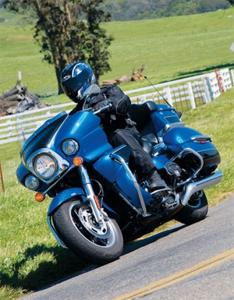 The fairing is frame-mounted, although reminiscent of the handlebar variety. Separate lowers protect the legs, and are integrated into the engine protectors. With the 17-inch look-through windscreen, a quiet pocket of air envelopes the rider and, to a lesser degree, the passenger. That is just one of the realities of passengering.
The fairing is frame-mounted, although reminiscent of the handlebar variety. Separate lowers protect the legs, and are integrated into the engine protectors. With the 17-inch look-through windscreen, a quiet pocket of air envelopes the rider and, to a lesser degree, the passenger. That is just one of the realities of passengering.
There is lots of engine to look at as well, and though the V-twin is liquid-cooled it has those cool-looking fins—which actually do help. A discreet amount of chrome bling is viewable, with matte black contrast. The covers on the big air cleaner appear on both sides of the Vee, to give plentiful oxygen to the fuel mixture, and are appropriately chromed. However, the larger image is the two-tone paint. There are two color choices: Candy Plasma Blue with Metallic Diablo Black, or Titanium with black accents.
This is Kawasaki’s third Voyager model. The first was the six-cylinder ZN1300 of 1983, a big heavy motorcycle that was great on the open road, but like a hippo when maneuvering around a greasy gas station. That was followed by the four-cylinder ZG1200 in 1986, which stayed in the line virtually unchanged for 18 years. And now there’s the two-cylinder version, based on the Vulcan line; Kawasaki would like to see this model around for the next 18 years as well.

The new engine is a 52-degree V-twin, taking good points from both the OHV Vulcan 2000 and the OHC Vulcan 1600. The 1700, with a bore of 102mm, stroke of 104mm, uses the four-valve heads and overhead cams of the 1600, while deploying two chain-driven counterbalancers off the crankshaft like the 2000. The factory claims some 108 lb-ft of crankshaft torque at just 2,750 rpm. Very useful stuff, that torque, especially coming on that low. That is the kind of power the cruiser pilot finds appealing, not the revvy stuff found on the sport-touring Concours 14. The 1700 is said to have 15 percent more horsepower than the 1600, too—not bad for a 6 percent increase in size. On the Jett Tuning Dynojet dyno, the Voyager delivered peaks of 72 horsepower and 93 lb-ft of torque at the rear wheel.
Here are the barest of details. The fuel is injected through two 42mm throttle bodies, compressed 9.5 times, and fired electronically via one spark plug in each head via TCBI—Transistor Controlled Breakerless Ignition. This is all optimized by an Electronic Throttle Valve (ETV) system, which involves a whole bunch of gadgetry like an Accelerator Position Sensor (APS) and Throttle Position Sensor (TPS). I don’t pretend to understand how that all works, but when I twist the throttle lots of good things happen. When rolling through town, going slowly, it is best to have a gentle hand on the throttle or there might be some abruptness. One other aspect of in-town riding is that on a hot day the rear cylinder puts out a lot of heat—a problem common to many big-twin cruisers.
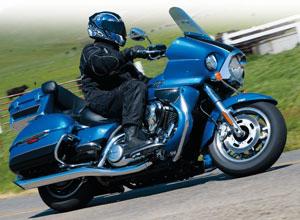 The crankshaft has a single pin, both connecting rods bolted to the same axis, providing a healthy sound through the two stock mufflers. Gears run the power back to the clutch, a smooth, hydraulically operated affair that is easy to use and has adjustment at the lever. The transmission is a brand-new six-speed, and quite precise, although it does make a healthy clunk when shifting in the lower gears; I never missed a shift. Some intermittent gear whine can be heard at modest speeds, too. Third and fourth are the power gears, and sixth is an overdrive for happy highway motoring. The engine turns an indicated 2,200 rpm at 65 mph in sixth—gentle going. Smooth acceleration comes from twisting the throttle if I’m in no rush, or I can drop the gearbox down two gears and move out more than briskly. Final drive is by a carbon-fiber-reinforced belt.
The crankshaft has a single pin, both connecting rods bolted to the same axis, providing a healthy sound through the two stock mufflers. Gears run the power back to the clutch, a smooth, hydraulically operated affair that is easy to use and has adjustment at the lever. The transmission is a brand-new six-speed, and quite precise, although it does make a healthy clunk when shifting in the lower gears; I never missed a shift. Some intermittent gear whine can be heard at modest speeds, too. Third and fourth are the power gears, and sixth is an overdrive for happy highway motoring. The engine turns an indicated 2,200 rpm at 65 mph in sixth—gentle going. Smooth acceleration comes from twisting the throttle if I’m in no rush, or I can drop the gearbox down two gears and move out more than briskly. Final drive is by a carbon-fiber-reinforced belt.
All this fits into a new steel frame, using a box-section spine and a double cradle beneath the engine. A fat 45mm fork is bolted to the steering head, with a 30-degree rake and 7 inches of trail. Wheelbase is 65.6 inches, shorter than that of both the 1600 and 2000 Vulcans. This makes for a very comfortable and stable straight-line ride, with a leisurely approach to the corners. Much attention has been paid to the rigidity of the frame, the ability to move through a curve briskly without any wobble, and it does an excellent job. At the back the swingarm has a shock absorber on each side that is air-adjustable (there is no balancing tube to equalize pressure, so they have to be adjusted independently) and has four rebound adjustments. The rider can run the system soft or stiff, depending on that day’s mood. For my ride I used 20 psi and the rebound in the third position. The fork has 5.5 inches of travel, the shock, 3.1 inches. On a relatively smooth highway the ride is very plush, while going down a frost-heaved road requires a certain discretion.
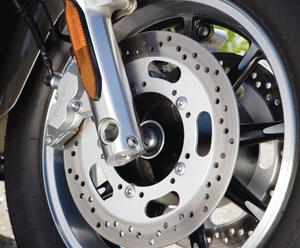
The standard Voyager comes with three 300mm discs; the front two are slowed by four-piston calipers, the rear by a twin-piston caliper. ABS is an option and was included on our test unit. It features Kawasaki’s Advanced Co-Active Braking Technology (K-ACT), which is controlled by the bike’s electronic control unit. To describe this complicated arrangement as simply as possible, whether you are using the lever or the pedal, or preferably both, the K-ACT knows how fast you are going and can then maximize braking efficiency by linking the brakes and modulating the pressure applied. The system did not inhibit my braking technique at all, and while I cannot say for sure that my braking distances were decreased through this mechanism, it felt fine.
Any genuine improvement in the world of braking is always appreciated by me. As the wags say, it’s not speed that kills, it is the sudden stop. And the more we can prevent these stops from being sudden, the better off we are.
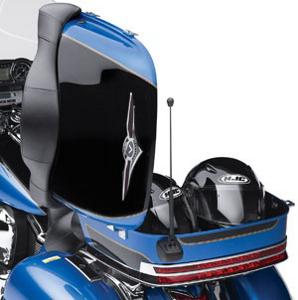
Carrying capacity? Lots. The two top-opening saddle- bags (or side cases) can swallow a lot of stuff, as each holds 10 gallons. Just remember to put your rainsuit at the top, not at the bottom. The trunk holds more than 13 gallons and can easily fit two large helmets, laid on their sides; the lid lifts to the side, making access easy even when a passenger is aboard. The fairing has two lockable glove boxes, each one holding about a quart. An optional luggage rack is available for the trunk, a good place to strap bulky lightweight things like a sleeping bag.
Then there are all the fussy bits touring riders like so much, beginning with cruise control. To control the cruise your right thumb can do all the work, and it works in the top four gears. It disengages below 30 mph and won’t exceed 85 mph. Sensible.
The dash uses a round analog speedo and tach, black-with-white lettering like something from the ’60s—none of this digital nonsense for a muscle bike. The LCD screen displays pertinent info like a fuel gauge for the 5.3-gallon tank, including range remaining in the tank and average fuel consumption (our test bike averaged 33.5 mpg), a clock, a gear indicator, an odometer and two tripmeters. I would have liked a tire-pressure readout as found on the Concours 14; curious omission.
The radio looks like something off the dash of a ’69 Mustang, and has two speakers up front, with two rear speakers being available. With the optional wiring in place you can control and display an iPod, XM or CB radio with the audio system. Fidelity is good, and the faster you go, the louder Bruce Springsteen gets…though as with all motorcycles fidelity deteriorates considerably at speed.
Throw a leg over the saddle, hoist the 895 pounds ready-to-ride off the sidestand—no mean feat. Turn the key, push the button and there’s instantaneous fire; the mufflers give out a pleasant burble. The rider has floorboards, with a heel-and-toe shifter. Toe down into first gear, the clutch lets out smoothly, a little throttle…and you’re away. Down the street, onto the avenue, then the freeway, clicking through the gears.
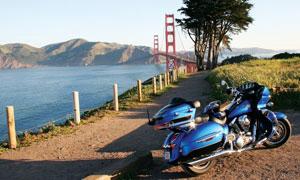 There’s good wind protection behind the tall ’sceen, and on a cool day you can close the vents on the leg shields. Now we exit onto Mountain Road, and the road narrows to two lanes and begins to twist. The Voyager has no problem, as the new frame provides a very reliable feeling. If you get a trifle enthusiastic, you might find the tilt-up footboards scraping, which gives you plenty of warning not to push it.
There’s good wind protection behind the tall ’sceen, and on a cool day you can close the vents on the leg shields. Now we exit onto Mountain Road, and the road narrows to two lanes and begins to twist. The Voyager has no problem, as the new frame provides a very reliable feeling. If you get a trifle enthusiastic, you might find the tilt-up footboards scraping, which gives you plenty of warning not to push it.
This is your long-haul touring cruiser, sea-to-shining-sea sort of bike. And it will get a lot of compliments along the way. Whether you are leaning into the curves on Interstate 15 as it twists through the Virgin River Gorge in Arizona, or rolling through Mississippi on the Natchez Trace Parkway, you will be a happy traveler on this Voyager.
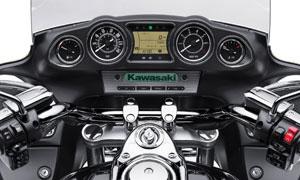
2009 Kawasaki Vulcan Voyager 1700 Specifications
Base Price: $16,799
Price as Tested: $17,899 (K-ACT ABS)
Warranty: 3 yrs., unltd. miles
Website: www.kawasaki.com
Engine Type: Liquid-cooled, transverse 52-degree V-twin
Displacement: 1,700cc
Bore x Stroke: 102.0 x 104.0mm
Compression Ratio: 9.5:1
Valve Train: SOHC, 4 valves per cyl.
Valve Adj. Interval: N/A
Fuel Delivery: Digital EFI w/ 42mm throttle bodies x 2
Lubrication System: Wet sump, 4.5-qt. cap.
Transmission: 6-speed w/ overdrive & hydraulically actuated wet clutch
Final Drive: Belt
Electrical
Ignition: TCBI w/ digital advance
Charging Output: 655 watts @ 5,000 rpm
Battery: 12V 18AH
Chassis
Frame: Tubular-steel double cradle w/ box-section single backbone & steel swingarm
Wheelbase: 65.6 in.
Rake/Trail: 30 degrees/7.0 in.
Seat Height: 28.7 in.
Suspension, Front: 45mm stanchions, no adj., 5.5-in. travel
Rear: Dual shocks, adj. air press. & rebound damping w/ 3.1-in. travel
Brakes, Front: Dual discs w/ 4-piston opposed calipers & K-ACT ABS (as tested)
Rear: Single disc w/ 2-piston pin-slide caliper & K-ACT ABS (as tested)
Wheels, Front: Cast, 3.50 x 16 in.
Rear: Cast, 4.50 x 16 in.
Tires, Front: 130/90-H16
Rear: 170/70-H16
Wet Weight: 895 lbs.
Load Capacity: 379 lbs.
GVWR: 1,274 lbs.
Performance
Fuel Capacity: 5.3 gals., last 1.3-gal. warning light on
MPG: 90 octane min. (low/avg/high) 28.4/33.5/36.6
Estimated Range: 178 miles
Indicated rpm at 60 mph: 2,100







